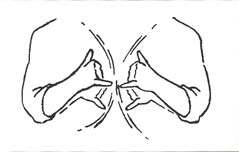
Illustration by Jennifer Macedo
 Illustration by Jennifer Macedo |
During the March of 1988, a student protest at Gallaudet University, which received world-wide media attention, resulted in the first deaf person being appointed president of the world's only liberal arts university for deaf and hard-of-hearing students. The week-long demonstrations were aimed at the board of trusteees' earlier decision to appoint a president who was not deaf and did not know sign language.
The demonstration, now known as the Deaf President Now (DPN) movement, led to I. King Jordan being installed as the eight-- and first deaf-- president of Gallaudet. The movement did a great deal of advance public understanding and sympathy for the language and culture of the deaf.
The DPN movement was a rebellion against decades of an education expectation that students adopt oralism (speech and lip reading only) of the dominant hearing culture. From 1880 until about 1970, oral education pioneered by Alexander Graham Bell, was the primary method of instruction for deaf children in the United States.
Over the past 25 years, most education programs moved from residential placement to public schools (mainstreaming) and from oralism to total communication-- a mehtod that incorporates all means of communication available to a teacher and student to include: speech, auditory training, finger spelling, signed English, reading and writing. Total communication today has evolved into what has come to mean simultaneous communication, defined as sing supported speech. The effort to speak in English and sign a prominent noun or verb at the same time often contributes to a breakdown in the intelligibility of the signed message for most deaf children (The Deaf Way, 1994).
Today, hardly anyone is pleased with total communication. One of the few points of agreement in the present debate is that deaf education is distressingly poor. The Commission on Education of the Deaf, for example, which reported to the President and Congress in 1988, began its account, "The present status of educaiton for persons who are deaf in the United States is unsatisfactory. Unacceptable so. This is (our) primary and inescapable conclusion." When deaf students eventually leave school, three in four are unable to read a newspaper and only two deaf children in a hundred (compared to forty in a hundred among the general population) go on to a college education (The Atlantic Monthly, September, 1993).
Harlan Lane, in his popular book, The Mask of Benevolence: Disabling the Deaf Community (1992), concedes the possibility that total communication may have been a necessary way on the road forom oralism to a new approach known as the bilingual/bicultural system, in whcih American Sign Language (ASL) is taught as the primary language and English as the second language. ASL must not be thought of as hand flapping English, but a language on par with English or any foreing language. Asl has its own structure, symbols, grammar, and is a fully functional language. It is a language, however, that has no writeen from-- thus the need for English as a second language.
It appears that the bilingual/bicultural system of deaf education may be the start of deaf people affirming ASL as the standard means of communication. As more teachers of the deaf become fluent in ASL and are hired by schools, ASL could become the preferred mode of communication through which English and all other subjects are taught.
Dr. David Martin, Professor within the Department of Education at Gallaudet University, asserts that if the bilingual/bicultural system of education is going to be effective, teachers of ASL should be brought to a level of ASL proficiency equal to that of near native-lie production and fluency-- ability to express and receive ASL as well as a child born to deaf parents where ASL is used universally. The teacher of ASL will need a superior score on the Sign Communication Proficiency Interview (SCPI) Rating Scale to be competent. Teachers of subject areas (e.g., physical education) will need to have an advanced proficiency rating on the SCPI-- able to sign with sufficient accuracy and vocabulary to participate effectively in most conversations.
What incentive could teacher preparation programs use to foster ASL proficiency in subject area teachers to ensure success of the biilingual/bicultural system? One strategy might be to work through college governance to win acceptance of ASL as a language fulfilling the foreign language requirement. This trend appears to be gaining momentum. Has your college/university taken a position on accepting ASL as a foreign language equivalent?